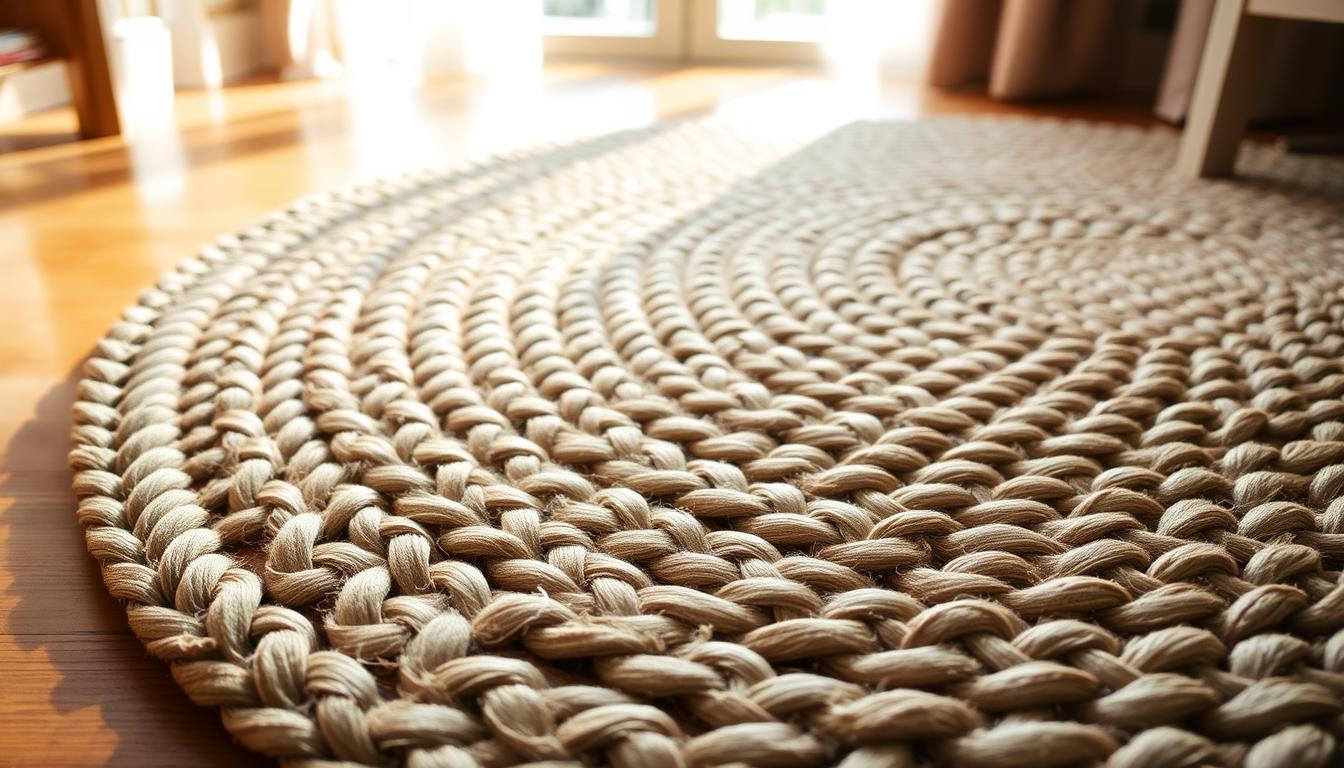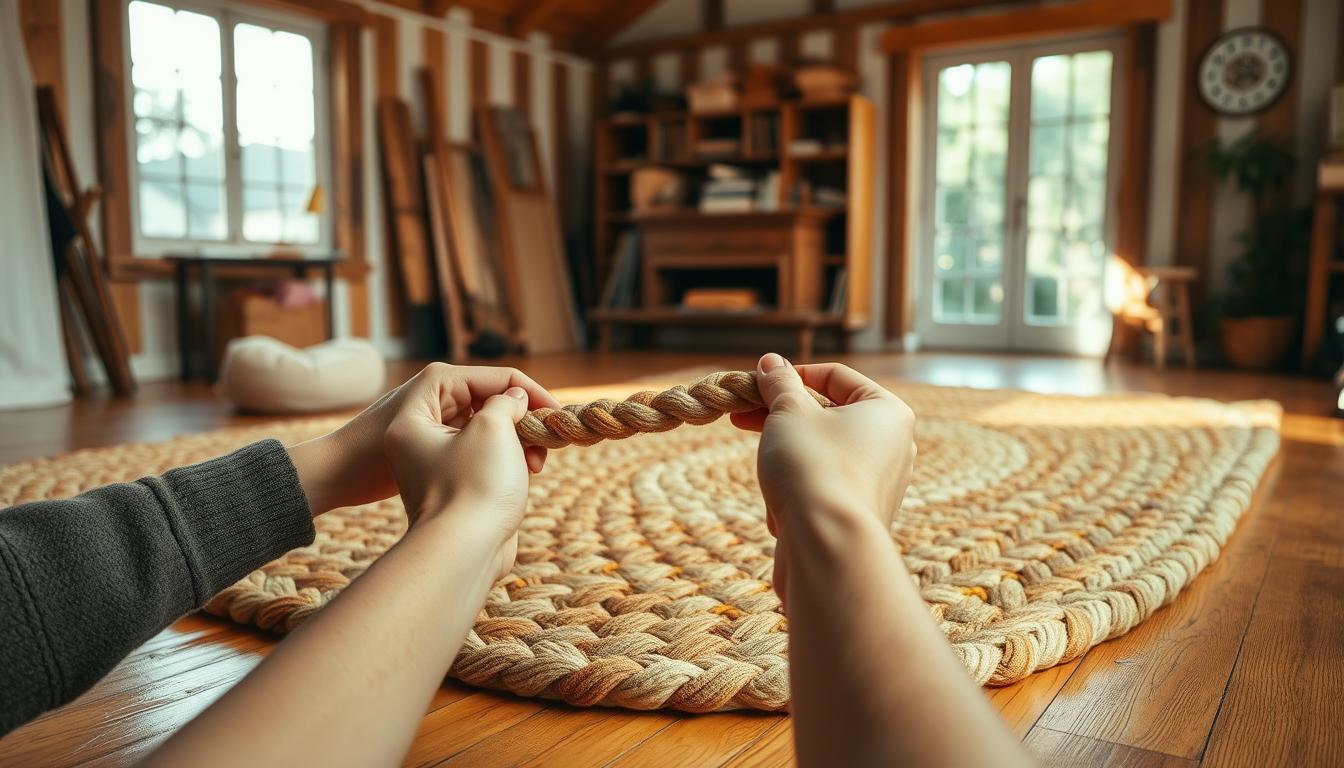
Braided Rug Care: 5 Simple Steps to Keep It Looking Fresh
What if the secret to preserving your favorite floor covering lies in methods older than America itself? For centuries, these handcrafted treasures have warmed homes and told stories of resourcefulness—but their dense, woven design demands a unique approach to maintenance. Let’s explore how to honor their legacy while keeping them vibrant.

Originating in early colonial times, these textiles began as scraps of fabric transformed by creative hands. Women repurposed leftover materials into durable, colorful pieces that served both practical and decorative roles. Today, their rustic charm remains unmatched—but without proper care, dirt can settle deep into the fibers, dulling their character.
Understanding your piece’s construction is critical. Tightly woven strands create cozy textures but trap debris easily. Our cleaning guide simplifies this process, offering modern solutions rooted in tradition. You’ll learn how to balance gentle techniques with effective results, ensuring your decor stays fresh through every season.
Key Takeaways
- Discover the 400-year history behind these iconic home accents, born from creative reuse of fabric scraps.
- Learn why their tightly woven design requires specialized cleaning methods to prevent damage.
- Master five time-tested techniques that protect both appearance and functionality.
- Identify crucial construction details that determine the safest cleaning approach.
- Preserve vibrant colors and textures using strategies perfected over generations.
Understanding Braided Rugs and Their Construction
Your floor decor’s lifespan depends on its structural blueprint. These woven textiles combine unique patterns and materials that directly influence maintenance strategies. Let’s decode how craftsmanship shapes care requirements.
Different Braiding Techniques: Banded, Cloth, Flat, and Yarn
Four core methods shape these pieces. Banded braid uses folded fabric strips for heavy-duty results—ideal for doorways or hallways. Cloth braid weaves softer material into flexible layers, perfect for cozy bedrooms. Delicate flat braid designs demand cautious handling, while yarn braid textures collect debris in their loops.
Why the Construction Affects Cleaning Methods
Thicker weaves like banded styles withstand vigorous vacuuming. Thin flat-braided pieces? They’ll fray if scrubbed too hard. Natural fibers like wool shrink with harsh detergents, but synthetic blends tolerate deeper cleaning. Always check your textile’s makeup before choosing solutions.
Cotton and jute respond well to mild soap, while nylon benefits from enzyme-based cleaners. Tightly wound yarn patterns need soft-bristle brushes to dislodge grit without unraveling stitches. Match your approach to the piece’s architecture, and you’ll preserve its charm for decades.
Braided Rug Care: Essential Tips for Longevity
Ever wondered why some floor coverings outlast generations while others fade quickly? These textiles merge centuries-old craftsmanship with modern practicality, demanding thoughtful maintenance to honor their dual nature.
Heritage and Modern Appeal
Originally crafted from repurposed fabrics, these pieces now blend rustic charm with contemporary durability. Their tight construction withstands heavy foot traffic in dining spaces and outdoor patios alike. You’ll find options matching coastal blues, farmhouse neutrals, or vibrant country patterns—each designed to age gracefully.
Natural fibers like wool develop richer patinas over time, while synthetic blends resist moisture in deck areas. This versatility makes them functional art pieces that adapt to your lifestyle without losing character.
The Impact of Regular Cleaning on Longevity
Dust settles deep between woven strands, acting like sandpaper on fibers. Weekly maintenance prevents this abrasive buildup. Gentle brushing preserves color intensity by removing grit before it embeds permanently.
Consistent care stops edges from fraying and keeps patterns crisp. Spot-treat spills immediately using mild solutions—harsh chemicals break down natural materials. Think of maintenance as preventive medicine for your decor.
Establishing routines helps catch loose threads or weak spots early. Address minor issues promptly, and your textile will reward you with decades of warmth and visual appeal.
Routine Braided Rug Maintenance
How do you protect floor art that works harder than your coffee table? The answer lies in consistent, mindful practices that balance preservation with practicality. Let’s break down strategies that keep your piece looking sharp without turning upkeep into a part-time job.
Smart Cleaning Patterns Matter
Establish a weekly vacuuming routine, focusing on entryways and hallways where shoes track in debris. Move the nozzle parallel to the braid direction—this prevents unraveling while lifting trapped particles. For low-traffic zones like bedrooms, reduce frequency to every other week but maintain consistency.
Pair vacuuming with gentle brushing using soft-bristle tools. This duo removes surface dust before it settles into crevices. One user reports, "A quick brush-down after vacuuming makes our dining area piece look brand-new for Sunday dinners."
Accident Response Protocol
When spills happen, act fast. Blot—don’t rub—using white cloths to avoid dye transfer. For food stains, scrape solids first with a dull knife edge. Test cleaning solutions on hidden edges before full application.
High-use areas benefit from monthly deep inspections. Check for loose threads or color shifts where sunlight hits hardest. These quick checks prevent small issues from becoming permanent flaws in your decor’s story.
Deep Cleaning Strategies for Braided Rugs
Your textile needs occasional intensive care to maintain its charm. While daily upkeep handles surface dirt, ground-in grime demands targeted approaches. Let’s explore professional-grade solutions adapted for home use.

Choosing Between Hand Washing and Machine Washing
Material type dictates your best option. Delicate natural fibers like wool thrive in cold water baths. Hand washing works best for larger pieces—submerge them in tubs with mild soap, gently agitating to lift debris. For specialized wool care, use pH-neutral solutions.
Machine washing suits compact synthetic textiles. Check manufacturer guidelines first. Use cold cycles and mesh bags to prevent unraveling. One user notes: "My 4x6 nylon piece comes out refreshed when washed monthly."
Safe Methods: Hose Cleaning, Foam Cleaning, and Steam Cleaning
Outdoor spaces become cleaning stations for polyester textiles. High-pressure hoses remove embedded dirt without chemicals. Follow with thorough drying to prevent mildew.
Foam cleaning tackles stubborn stains. Apply rug shampoo with soft brushes, working in circular motions. Rinse completely—residue attracts more dirt over time.
| Method | Best For | Key Steps |
|---|---|---|
| Steam Cleaning | All materials | Use low heat, approved detergents |
| Machine Wash | Synthetics under 5' | Cold water, gentle cycle |
| Hose Wash | Outdoor polyesters | High-pressure rinse, air dry |
Steam systems offer deep sanitization for high-traffic areas. Always test settings on inconspicuous areas first. Our comprehensive cleaning guide details temperature limits for various fibers.
Schedule intensive sessions every 6-12 months. Busy households may need quarterly treatments in entryways. Consistent deep cleaning preserves both appearance and structural integrity.
Handling Specific Stains and Spills on Your Braided Rug
Accidents test your decor’s resilience, but quick action preserves its beauty. Whether it’s spilled wine or muddy paw prints, targeted techniques keep fibers vibrant. Let’s explore science-backed solutions that respect your textile’s heritage while tackling modern messes.
Food, Beverage, and Pet Accident Remedies
Blot spills within 30 seconds using a clean cloth—press firmly to lift liquids upward. For coffee or juice, mix equal parts white vinegar and water. Dab the solution gently, then rinse with cold water. One homeowner shares: "This method saved my heirloom piece after a cranberry sauce disaster."
Pet accidents need enzymatic cleaner. These formulas break down proteins at the molecular level. Apply generously, let sit 15 minutes, then blot. Follow with baking soda to neutralize odors overnight. Vacuum residue in the morning.
Using Mild Detergents and Natural Cleaning Agents
Create a gentle mild detergent mix: 1 tsp clear dish soap + 1 cup warm water. Test on hidden edges first. For oil-based stains, sprinkle baking soda to absorb grease before cleaning.
Natural solutions outperform harsh chemicals. Vinegar disinfects without bleaching colors. Baking soda lifts odors from deep fibers. Always use white cloths—dyed fabrics transfer pigments during cleanup.
| Solution | Best For | Action Time |
|---|---|---|
| Vinegar Mix | Food/drink stains | Immediate |
| Enzymatic Cleaner | Pet accidents | Within 1 hour |
| Baking Soda | Odors & grease | Overnight |
Avoid scrubbing—it pushes debris deeper. Instead, use patting motions with damp cloths. Dry thoroughly using fans or open windows to prevent mildew. Your quick thinking today ensures lasting beauty tomorrow.
Using Safe Cleaning Agents and Techniques
What if your floor art hid secret codes for its preservation? Every textile whispers clues about its ideal maintenance through material composition and dye stability. Mastering these signals ensures your cleaning efforts enhance rather than erode its beauty.

Test Before You Invest
Always conduct a spot check in hidden corners. Apply your chosen cleaner to a coin-sized area using a white cloth. Wait 24 hours—this reveals color bleeding or texture changes. One user learned the hard way: "Blue detergent turned my ivory edges green overnight."
Guard Against Gradual Damage
Harsh chemicals act like invisible sandpaper on natural fibers. Choose pH-neutral detergent for wool or jute. When washing, use lukewarm water—hot temperatures loosen dyes. Dry pieces indoors to avoid sunlight fading, rotating them every hour for even airflow.
Create a simple safety checklist:
- Read ingredient labels—avoid bleach or ammonia
- Match solution strength to fiber durability
- Blot instead of scrubbing to prevent fraying
Manufacturer tags often hold vital clues. Our detailed cleaning guide decodes these symbols, helping you choose the right way to clean braided textiles. Remember: gentle care today means vibrant colors tomorrow.
Tips for Rotating, Protecting, and Storing Your Braided Rug
How do you shield a functional heirloom from daily wear while keeping its story intact? Strategic placement and seasonal adjustments preserve both beauty and structure. Start by evaluating high-use zones and seasonal light patterns in your space.
Rug Pads and Regular Rotation for Even Wear
A quality rug pad prevents slipping and reduces friction against floors. Rotate your textile every 3-6 months, especially in entryways or dining areas with heavy foot traffic. This simple habit distributes wear evenly, preventing permanent indentations.
For synthetic pieces in busy households, consider our rotation schedule guide. It details how often to turn textiles based on room use and fiber type. Pair this with periodic deep cleaning for optimal results.
Proper Storage Away from Direct Sunlight and Moisture
When storing, choose spaces away from direct sunlight to prevent fading. Basements or attics with controlled humidity work best. Always ensure pieces are dry completely before rolling—use fans to air dry damp areas thoroughly.
Follow our synthetic textile storage tips for moisture-sensitive materials. Roll textiles loosely with acid-free paper to avoid creases. Never fold—tight bends weaken fibers over time. With these steps, your decor remains ready for its next chapter.
FAQ
How often should I clean my braided floor covering?
Vacuum weekly to remove loose dirt, and perform a deep clean every 3–6 months, depending on foot traffic. For spills, address them immediately to prevent stains.
Can I machine-wash smaller designs made with fabric strips?
Hand washing is safer for most materials. If using a machine, select a gentle cycle with cold water and mild detergent, but check the manufacturer’s guidelines first.
What’s the best way to remove pet accidents or food spills?
Blot liquids with a dry cloth, then apply a mix of warm water and baking soda. Avoid harsh chemicals—natural agents like vinegar work well for odor removal.
How do I prevent colors from fading over time?
Rotate the piece every few months to ensure even sun exposure. Keep it away from direct sunlight and use rug pads to minimize friction damage.
Is steam cleaning safe for densely woven styles?
Test steam on a hidden area first. High heat or moisture can loosen braids or shrink natural fibers like wool. Low-pressure settings are preferable.
What’s the proper method for drying after washing?
Lay it flat on a clean, dry surface outdoors or in a well-ventilated room. Avoid hanging, as weight can distort the shape. Ensure it’s completely dry before reuse.
Can I use bleach on stubborn stains?
Bleach weakens fibers and causes discoloration. Opt for oxygen-based cleaners or diluted dish soap instead. Always spot-test first.
How should I store seasonal pieces long-term?
Roll—don’t fold—to prevent creases. Wrap in breathable fabric and store in a cool, dry place. Add cedar blocks to deter pests.









